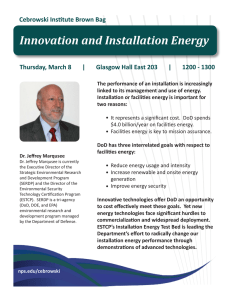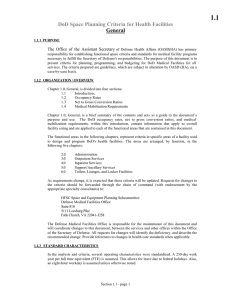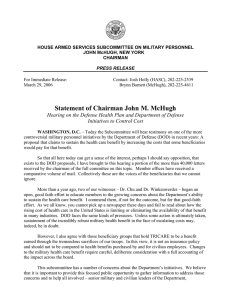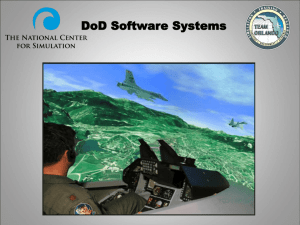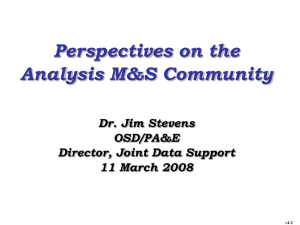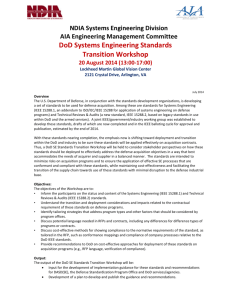DOD
advertisement
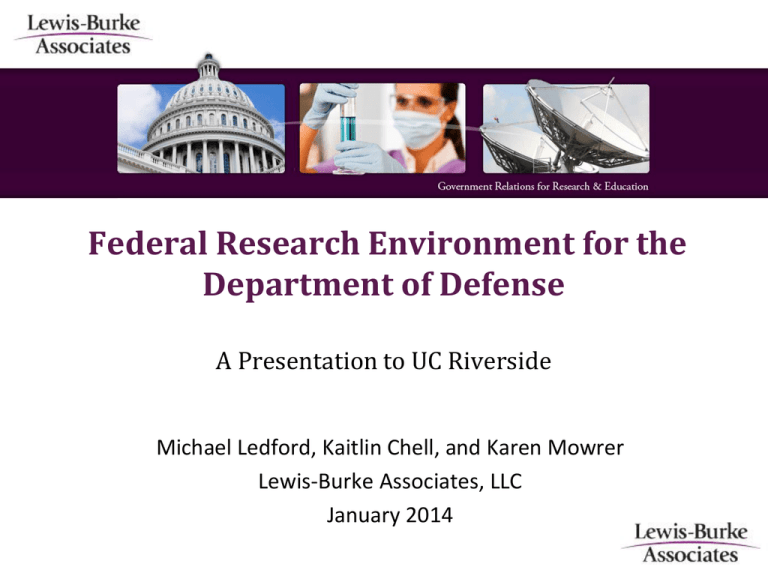
Federal Research Environment for the Department of Defense A Presentation to UC Riverside Michael Ledford, Kaitlin Chell, and Karen Mowrer Lewis-Burke Associates, LLC January 2014 Lewis-Burke Associates, LLC Lewis-Burke Associates, LLC is a leading full-service government relations firm specializing in advocating for the public policy interests of institutions of higher education and other research and education organizations • Began working with UC Riverside in November 2012 • 23 professional staff members • 26 clients, all nonprofits involved in research and/or education – 15 universities – 3 contractors running national research facilities – 8 associations 2 Select Services • Advanced intel on new programs and emerging agency themes. • Strategic university-wide agenda development. • Enhancing resources for researchers. – Information on new funding initiatives and prominent solicitations. – Support for post-docs and graduate students. – Thematic deep dives on federal funding. – Support for early career faculty. • Coalition building. • Program and project support at both political and policy levels. • Positioning and profile enhancement. 3 Department of Defense • DOD basic and applied research priorities in FY 14 despite overall RDTE cuts – However, DOD officials indicate investment accounts will be cut in FY 2015 budget request – Success rates lower, fewer extensions, some select areas cut by as much as 20-30% – Air Force and Navy positioned to do better than Army • Ongoing debate about feasibility of Strategic Guidance if sequester not reversed (long-term) 4 – Service branch research offices implementing cuts differently – Cognitive sciences, synthetic biology, advanced materials, and quantum information sciences key foci; maintaining technological workforce also a major concern (particularly cyber) – Shift to Asia is still an undercurrent Service Branch Research Offices • Army Research Office – Continues strong focus around broad basic research topics including physics, materials, computing, engineering, life sciences, and environmental sciences – Emphasis remains around broad scientific areas, but ARO is aligned with crosscutting DOD priorities like big data, manufacturing, and materials • Office of Naval Research – Leading funder of basic research across service branches – Priorities include sensors/communications, energy, and portable weapons • Air Force Office of Scientific Research – Recent realignment under five new thrust areas reflects increasing interdisciplinary approach to funding research – Priorities include cyber/information science, materials, alternative energy, and communications 5 Signature DOD Funding Mechanisms • Standard grants and contracts – – Broad Agency Announcements – Special program announcements (e.g. Minerva, Multidisciplinary University Research Initiative (MURI), Young Investigator Programs) • Cooperative Research Agreement (CRA) • Cooperative Technology Agreement (CTA) • Center of Excellence (COE) • Indefinite Delivery Indefinite Quantity (IDIQ) contracts 6 Other DOD Research Entities • DARPA – Focused on game-changing R&D around threats of the future; program managers enjoy broad autonomy in funding projects • SEED awards also possible for ideas with promise but more demonstration necessary – Cyber/cloud computing, big data, and health/biological research top priorities under new Director Prabhakar • DTRA – Basic and applied research on bio/chemical/nuclear/information sciences geared towards countering weapons of mass destruction – Small, but underutilized research opportunity for universities (~$50 m in basic research) • Chemical-Biological Research (~$60 million) – Targeted BAAs released throughout the year – Non-medical: nano, cognition, information science, bioscience – Medical Biological Defense Transformational Medical Technologies Initiative: diagnostic technologies, vaccine, therapeutic – viral, toxin, bacterial – Medical Chemical Defense – Smallest Area: respiratory, cutaneous and ocular, neurological, toxicology 7 SERDP/ESTCP • Workshops – identify key priorities (e.g. groundwater contamination, sustainable water usage, climate change, energy and water, materials research for stealth warfare technology, etc.) • SERDP-reducing energy and water consumption; invests in both basic and applied • ESTCP-technology demonstration and validation program • SERDP Core Solicitation – Pre-proposals due Jan 9, SEED Solicitation – Proposals due Mar 14. • ESTCP likely early 2014 release • New leadership (Acting: Anne Andrews) at SERDP/ESTCP presents opportunities for changes; ARPA-E Workshop good 8 opportunity Intelligence Community: Opportunities for Engagement • NSA (National Security Agency) – Centers of Excellence for Information Assurance – Academic and Research – New emphasis on “cyberdefense” – e.g., Key research topics – Mobility, Software assurance, Virtualization, • DIA/ODNI (Defense Intelligence Agency) – Centers for Academic Excellence (Jan 2014) – Postdoc Research Fellowships (Nov 2013) • NGA (National Geospatial Intelligence Agency) – NARP - Academic Research Program (BAA –Winter 2014) • University research initiatives – basic research • Research Collaboration Grants - GEOINT • New Scientific and Technical Innovative Research grants (early career) • IARPA (Intel Community – DARPA) 9 – Select Programs – Abstracts and Proposers’ Day conference CRITICAL – Active BAAs (Office of Incisive Analysis, Office of Safe & Secure Operations, Office of Smart Collection) – New: bio-intelligence chip (i.e. exposure to chem-bio agents). Other Key Defense Health Engagement Areas • Congressionally Directed Medical Research Program (CDMRP) – Broad umbrella with active solicitations throughout the year (typically 1/year for each sub-program – e.g. Breast Cancer Research, TBI, etc.) • Combat Casualty Care – Device, mobile, on site interventions, traumatic brain injury • Telemedicine and Advanced Robotics (TATRC) – Medical devices, trauma, neuroscience, biomaterials • Social and Behavioral Research: – Cross DOD - Human Social Cultural Behavioral Modeling (~$20 million) • Minerva Program (basic research) – U.S. Army Research Institute for the Behavioral and Social Sciences – ARO - Cultural and Behavioral, Institutional and Organizational Science 10 Looking Ahead • Must lead with DOD mission to be responsive to sponsor needs • R&D and basic research still a TOP priority on both sides of the aisle in Congress, but there is competition for limited dollars as more institutions turn toward DOD • Public-private partnerships will remain the favored mechanism for very large-scale efforts • Proposers Days, RFIs, and meetings with program managers still key to determining and influencing agency policy and research directions • Shared milestones and progress reports part of the culture 11 Contact Kaitlin Chell Lewis-Burke Associates LLC 1341 G Street, NW Eighth Floor Washington, D.C. 20005 e: kaitlin@lewis-burke.com p: 202.289.7475 f: 202.289.7454 www.lewis-burke.com 12
